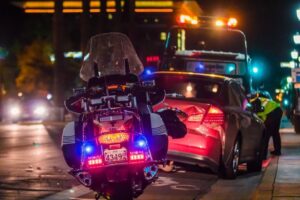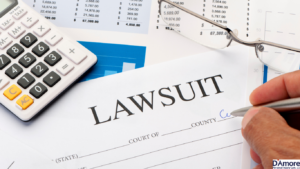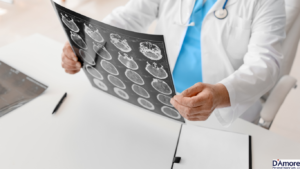
What Makes Motorcycle Accident Lawsuits Different?
Motorcycle riders have the same rights as all other road users, yet they are often overlooked or disregarded by other
D'Amore Personal Injury Law, LLC
Serious Injury Lawyers Proudly Serving
Baltimore, Annapolis, & Washington, D.C.
Motorcycle riders have a bad reputation for being reckless and dangerous drivers. With the ability to move quickly between vehicles, some riders take advantage and put others on the road in serious danger.
However, most motorcyclists are not pulling aggressive moves when out for a ride, and are more likely to become the victim of other driver’s careless behaviors.The National Highway Traffic Safety Administration (N.H.T.S.A.) reports that motorcyclists were about 22 times more likely than passenger vehicle occupants to die in a motor vehicle crash and were 4 times more likely to be injured. In 2022, 6,128 or 15% of traffic fatalities involved a motorcycle. This is the highest number of motorcyclists killed since 1975. Between increased driving distractions, poor road design, and excessive speeding, it’s becoming more deadly than ever for motorcycle riders to share the roads with other vehicles, even when they follow all the traffic laws themselves.
Spring is the beginning of cruising weather for avid motorcyclists around the country. To spread awareness on how to keep riders safe on the road this season, May is the kickoff of Motorcycle Safety Awareness Month. By encouraging others to stay alert and spreading the word on the dangers of not sharing the roads with motorcycles, you can help keep Maryland motorcyclists safe in hopes to reduce the risk of serious and fatal accidents in the future.
The Insurance Institute for Highway Safety (I.I.H.S.) reports that motorcycle deaths accounted for at least 14 percent of all motor vehicle crash deaths in 2021. Among the 6,084 motorcyclists killed in 2021…
Cruiser/standard motorcycle models appeared to have the most fatal crashes, resulting in 1,733 deaths overall. Though all roads can pose a risk to motorcyclists, non-interstate major roads posed the most danger for riders in 2021, responsible for 3,261 of the 6,084 fatalities. Other types of roads where fatalities occurred included minor roads (2,099) and interstates and freeways (695).
In October 2018, Richard Plunkard was riding his motorcycle in Smithsburg, Maryland when he was struck by a car who failed to see him before they pulled out. According to Local DVM, Plunkard suffered from broken bones in his eye, elbow, shoulder, hip, and femur, an impacted eyeball in his skull, an amputated pinky finger, and the loss of one of his ankles- thankfully, he was wearing his helmet.
Catastrophic outcomes such as these are common when describing motorcycle accidents. Aside from minimal padding and a helmet, motorcycle riders have little protection in the case of an accident, particularly when they come head-to-head with a car or truck. Examples of some of the common injuries that can result from a motorcycle accident include:
The forceful impact on a motorcyclist’s body caused by the road, a car, or a stationary object (bridge, median, pillar, etc.) can set them up for a life-long recovery and permanent injuries. When riders do not wear a helmet or padded clothing while riding, the risk of these injuries leading to fatal consequence skyrockets. In 2002, The American Journal of Public Health did a study on the Maryland All-Rider Motorcycle Helmet Use Law that was enacted on October 1, 1992. The study showed that the fatality rate dropped from 10.3 per 10,000 registered motorcyclists prelaw to 4.5 post-law despite almost identical numbers of registered motorcyclists. Despite this controversial law, it appears to be an effective public health policy and may be responsible for saving many lives.
Only four days into the new year when Maryland saw its first fatal motorcycle accident in Hagerstown when a motorcyclist died after colliding with a van near Valley Mall. St. Patrick’s Day weekend in March, Maryland State Police had a busy weekend investigating 3 fatal motorcycle accidents, in Anne Arundel County, Queen Anne’s County and Charles County. April saw our highest motorcycle fatal crash report at 10 according to Maryland’s Zero Crash Data Dashboard.
In addition to the basic rules of the road that motorcyclists must obey there are several additional laws in place to protect riders.
Drivers of cars and motorcycles both have a responsibility to keep each other safe on the road. Because motorcyclists have minimal protection in the case of an accident, drivers of cars and trucks must keep a close eye out for these vehicles to prevent a collision. Safely Home provides these tips for drivers and motorcyclists to help them avoid becoming a statistic this riding season:
Drivers:
Riders:
Attorneys at D’Amore Personal Injury Law are dedicated advocates for motorcycle safety. We believe everyone has the right to ride safely on our roads, not just cars and trucks. Motorcyclists shouldn’t have to accept injuries and accidents because drivers of other vehicles are neglecting to watch for them.
Our Maryland motorcycle accident attorneys have the trial experience to protect your rights and fight for the compensation you need and deserve. Contact us today 410-324-2000 to get the justice you deserve. Our consultation is free, and there is no fee unless we win!
Fill out the form below and we will contact you.
Or, give us a call at

Motorcycle riders have the same rights as all other road users, yet they are often overlooked or disregarded by other

Understanding Medical Malpractice Settlements in Maryland Medical malpractice cases can be emotionally and financially devastating for victims and their families.

How Long Does It Take to Settle a Traumatic Brain Injury Case in Maryland? Traumatic brain injuries (TBIs) can have